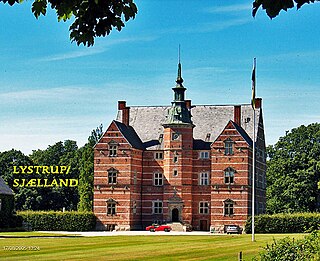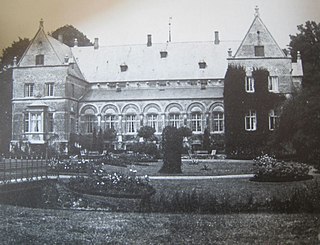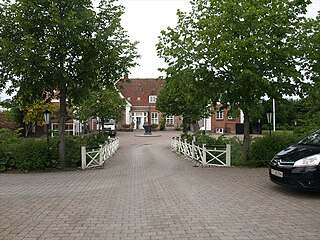
Assistens Cemetery in Copenhagen, Denmark, is the burial site of many Danish notables as well as an important greenspace in the Nørrebro district. Inaugurated in 1760, it was originally a burial site for the poor laid out to relieve the crowded graveyards inside the walled city, but during the Golden Age in the first half of the 19th century it became fashionable and many leading figures of the epoch, such as Hans Christian Andersen, Søren Kierkegaard, Christoffer Wilhelm Eckersberg, and Christen Købke are all buried here.

Meilgaard Castle is a castle and estate located in Glesborg Parish in Norddjurs Municipality, Denmark. It is situated between Fjellerup Strand and Bønnerup Strand on the Djursland peninsula.

Hjort, also spelled Hiort and Hiorth, is a common surname of some Norwegian and Danish families and persons. The name means hart.
The Diocese of Zealand was a Lutheran diocese in Denmark that existed from 1537 to 1922. The diocese had been formed in 1537 following the Reformation of Denmark, and was dissolved in 1922 when it was divided into the Diocese of Copenhagen and the Diocese of Roskilde. While it existed, the diocese functioned as the head of the Church of Denmark, beneath the crown, and its bishop was regarded as Primus inter pares.
Events from the year 1716 in Denmark.

Eriksholm Castle is a manor house located at the foot of the Isefjord inlet, 6 km south-east of Holbæk, in east Denmark. The history of the estate dates back to 1400 but today's house was built in 1788 to a Neoclassical design by Caspar Frederik Harsdorff, the leading Danish architect of the time. It was listed in the Danish registry of protected buildings and places in 1918.

Kongsdal /1280ndash]]1661: Tygestrup) is a manor house and estate located approximately 14 kilometres (8.7 mi) southwest of Holbaek, between Undløse and Mørkøv, Holbæk Municipality, some 60 km west of Copenhagen, Denmark. The three-winged main building from the 1590s was listed in the Danish registry of protected buildings and places in 1918.

Rønnebæksholm is a former manor house located just outside Næstved in south-eastern Denmark. The estate covers 230.5 hectares of land. It was acquired by Næstved Municipality in 1998 and is now run as a cultural centre, hosting a wide range of cultural events, both indoor and outdoor, including art exhibitions, concerts, talks and theatrical performances.

Lystrup is a manor house and estate located two kilometres west of Faxe, in Faxe Municipality, Denmark. The Dutch Renaissance style main building was built in 1579 for Chancellor of the Realm Eiler Grubbe (1532–1585). In the late 1600s, the main building was rebuilt and a new south wing was erected.
Gunderslevholm is a manor house and estate located 12 km northwest of Næstved in southeastern Denmark. Gunderslevholm has been owned by members of the de Neergaard family since 1803. The main building is located on high ground just west of the Susaa river. It was originally a Baroque-style mansion built in 1729 for Carl Adolph von Plessen but was in 1787 adapted to the Neoclassical style. Gunderslevholm covers 2,020 hectares of land and 276 hectares of lake (2023).

The Danish Constituent Assembly is the name given to the 1848 Constitutional assembly at Christiansborg Palace in Copenhagen that approved the Danish Constitution and formalized the transition from absolute monarchy to constitutional democracy. It consisted of members of which 114 were elected by the people, 38 were appointed by the king and the rest were government ministers.
Rosengaard is a manor house and estate in Ringsted Municipality, Denmark.
Espe is a manor house and estate in Denmark. It is located at Boeslunde, between Korsør and Skælskør, Slagelse Municipality, some 100 kilometres southwest of Copenhagen. Espe has been listed on the Danish registry of protected buildings and places since 1918. The main building dates to the 18th century but was adapted to the Late Neoclassical style in 1848. The manor and estate has been owned by members of the Moltke family since 1810.
Mørup is a manor house and estate located close to Sorø, Denmark. It is now owned by Sorø Academy The half-timbered main building dates from the beginning of the 19th century.

Kragerup, also known as Kragerupgaard, is a manor house and estate located close to Høng, Kalundborg Municipality, some 90 kilometres southwest of Copenhagen, Denmark. The estate has been owned by the Dinesen family since 1801. The main building is now operated as a hotel. It was listed on the Danish registry of protected buildings and places in 1918.

Selchausdal, formerly Gundetved, is a manor house and estate located on the east side of Tissø, Kalundborg Municipality, some 0+ kilometres west of Copenhagen, Denmark. The three-winged Renaissance Revival style main building is from 1857 and was designed by Johan Daniel Herholdt. It was listed on the Danish registry of protected buildings and places in 1978.
Alslevgaard is a manor house and estate located at Karise, Faxe Municipality, Denmark. The estate was for 300 years owned by the Grubbe family and has for long periods of time shared ownership with Tryggevælde. Both estates belonged to the Countship of Bregentved from 1751 to 1922 under grevskabet Bregentved, der blev oprettet af A. G. Moltke. The old main building was demolished in the middle of the 18th century and a new main building was not built until 1902. The oldest parts of the farm buildings (avlsgården) dates from circa 1775.
Gerdrup, formerly Gjerup, is a manor house and estate located three kilometres north of Skælskør, Slagelse Municipality, Denmark. The estate was from 1760 to 1919 owned by members of the Qvistgaard family and has since then been owned by the Fabricius family. The current main building is from 1866. It is now operated as a venue for meetings, parties and other events.

Sørup is a manor house and estate located 6 kilometres south of Ringsted, Denmark. The current Historicist main building was constructed after a fire in 1909. It is now operated as a hotel and conference centre.

Ove (Offe) Skade was a Danish courtier and fiefholder who served as the first Prefect of the Diocese of Zealand.














